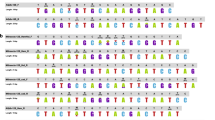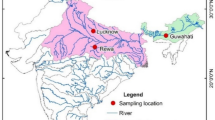Abstract
Species of the genus Daphnia, in particular the subgenus Hyalodaphnia, represent a taxonomically problematic group due to their phenotypic plasticity, local races and the formation of interspecific hybrids and backcrosses. In this study, we present a genetic approach utilising nuclear DNA to unequivocally identify species and interspecific hybrids. Several nuclear loci (ITS1-ITS2, CA14 and GA13) were amplified by PCR and products were subjected to diagnostic restriction enzymes (restriction fragment length polymorphism; RFLP). The application of this approach to several populations across Europe revealed that the markers are highly consistent and reproducible. In addition, we illustrate with a number of examples how this approach contributed to unravel previously unrecognised taxa, increased the sensitivity of biodiversity studies or contributed to the analysis of resting egg banks. Advantages and disadvantages of this approach compared to existing techniques are discussed and several empirical studies and their results are summarised.
Similar content being viewed by others
References
Aguilar, J. F., J. A. Rossello & G. N. Feliner, 1999. Nuclear ribosomal DNA (nrDNA) concerted evolution in natural and artificial hybrids of Armeria (Plumbaginaceae). Molecular Ecology 8: 1341-1346.
Balloux, F. & N. Lugon-Moulin, 2002. The estimation of population differentiation with microsatellite markers. Molecular Ecology 11: 155-165.
Banta, A. M., 1913. One hundred parthenogenetic generations of Daphnia without sexual forms. Proceedings of the Society for Experimental Biology and Medicine 11: 180-182.
Bert, T. M., K. J. McCarthy, H. Cruzlopez & S. Bogdanowicz, 1996. Character discriminatory power, character-set congruence, and the classification of individuals from hybrid zones: an example using stone crabs (Menippe). Evolution 50: 655-671.
Boecklen, W. J. & D. J. Howard, 1997. Genetic analysis of hybrid zones: numbers of markers and power of resolution. Ecology 78: 2611-2616.
Carvalho, G. R. & D. J. Crisp, 1987. The clonal ecology of Daphnia magna. I. Temporal changes in the clonal structure of a natural population. Journal of Animal Ecology 56: 453-468.
Colbourne, J. K. & P. D. N. Hebert, 1996. The systematics of North American Daphnia (Crustacea: Anomopoda): a molecular phylogenetic approach. Philosophical Transactions of The Royal Society London B 351: 349-360.
Colbourne, J. K., P. D. N. Hebert & D. J. Taylor, 1997. Evolutionary origins of phenotypic diversity in Daphnia. In Givnish, T. J. & K. J. Sytsma (eds), Molecular Evolution and Adapative Radiation. Cambridge University Press 163-188.
Cousyn, C., L. De Meester, J. K. Colbourne, L. Brendonck, D. Verschuren & F. Volckaert, 2001. Rapid, local adaptation of zooplankton behavior to changes in predation pressure in the absence of neutral genetic changes. Proceedings of The National Academy Sciences of The United States of America 98: 6256-6260.
De Meester, L., 1996. Local genetic differentiation and adaptation in freshwater zooplankton populations: patterns and processes. Ecoscience 3: 385-399.
Dodson, S. I., 1989. The ecological role of chemical stimuli for the zooplankton: predator-induced morphology in Daphnia. Oecologia 78: 361-367.
Dover, G. A., A. R. Linares, T. Bowen & J. M. Hancock, 1993. Detection and quantification of concerted evolution and molecular drive. In Zimmer, E. A. & T. J. White (eds), Molecular Evolution: Producing the Biochemical Data, Methods in Enzymology 224. Academic Press Inc. 525-541.
Dowling, T. E., C. Moritz, J. D. Palmer & L. H. Rieseberg, 1996. In Hillis, D. M., C. Moritz & B. K. Mable (eds), Molecular Systematics, Second Edition. Sinauer Associates, Inc. Publishers Sunderland, MA, USA.
Ender, A. & B. Schierwater, 1993. Identification of nuclear markers in Daphnia hybrid complexes using Random Amplified Polymorphic DNA (RAPD). Verh. Dt. Zool. Ges. 86: 45.
Ender, A., K. Schwenk, T. Staädtler, B. Streit & B. Schierwater, 1996. RAPD identification of microsatellites in Daphnia. Molecular Ecology 5: 437-441.
Flößner, D., 2000. Die Haplopoda und Cladocera (ohne Bosminidae) Mitteleuropas. Backhuys Publishers, Leiden: 428 pp
Fryer, G., 1996. Diapause, a potent force in the evolution of freshwater crustaceans. Hydrobiologia 320: 1-14.
Gießler, S., 1997. Analysis of reticulate relationships within the Daphnia longispina species complex. Allozyme phenotype and morphology. Journal of Evolutionary Biology 10: 87-105.
Hairston, N. G., 1996. Zooplankton egg banks as biotic reservoirs in changing environments. Limnology and Oceanography 41: 1087-1092.
Hairston, N. G., Jr., W. Lampert, C. E. Caceres, C. L. Holtmeier, L. J. Weider, U. Gaedke, J. M. Fischer, J. A. Fox & D. M. Post, 1999. Rapid evolution revealed by dormant eggs. Nature 401: 446.
Havel, J. E. & P. D. N. Hebert, 1993. Daphnia lumholtzi in North-America — another exotic zooplankter. Limnology and Oceanography 38: 1823-1827.
Hebert, P. D. N. & R. D. Ward, 1972. Inheritance during parthenogenesis in Daphnia magna. Genetics 71: 639-642.
Hebert, P. D. N., 1995. The Daphnia of Northern America: An Illustrated Fauna, CD-ROM, Distributed by the Author. Department of Zoology, University of Guelph, Guelph, Ontario.
Hobæk, A., M. Skage & K. Schwenk, 2004. Daphnia galeata × Daphnia longispina hybrids in western Norway. Hydrobiologia 526: 55-62.
Hrbáçek, J., 1987. Systematics and biogeography of Daphnia species in the northern temperate regions. In Peters, R. H. & R. de Bernardi (eds), Daphnia. Mem. dellíistituto Ital. di Idrobiologia. Consiglio Nazionale delle Richerche: 245-284.
Kerfoot, W. C., J. A. Robbins & L. J. Weider, 1999. A new approach to historical reconstruction: combining descriptive and experimental paleolimnology. Limnology and Oceanography 44: 1232-1247.
Lynch, M., 1983. Ecological genetics of Daphnia pulex. Evolution 37: 358-374.
Lynch, M., M. Pfrender, K. Spitze, N. Lehman, J. Hicks, D. Allen, L. Latta, M. Ottene, F. Bogue & J. Colbourne, 1999. The quantitative and molecular genetic architecture of a subdivided species. Evolution 53: 100-110.
Mort, M. A., 1991. Bridging the gap between ecology and genetics: the case of freshwater zooplankton. Trends in Ecology and Evolution 6: 41-45.
Nason, J. D. & N. C. Ellstrand, 1993. Estimating the frequencies of genetically distinct classes of individuals in hybridized populations. Journal of Heredity 84: 1-12.
Perez, T., J. Albornoz & A. Dominguez, 1998. An evaluation of RAPD fragment reproducibility and nature. Molecular Ecology 7: 1347-1357.
Peters, R. H., 1988. Some general problems for ecology illustrated by food web theory. Ecology 69: 1673-1676.
Repka, S., S. Veselá, A. Weber & K. Schwenk, 1999. Plasticity in faltering screens of Daphnia cucullata × galeata hybrids and parental species at two food concentrations. Oecologia 120: 485-491.
Rieseberg, L. H., 1996. Homology among RAPD fragments in interspecific comparisons. Molecular Ecology 5: 99-105.
Schwenk, K. & P. Spaak, 1995. Evolutionary and ecological consequences of interspecific hybridization in cladocerans. Experientia 51: 465-481.
Schwenk, K., A. Ender & B. Streit, 1995. What can molecular markers tell us about the evolutionary history of Daphnia species complexes? Hydrobiologia 307: 1-7.
Schwenk, K., D. Posada & P. D. N. Hebert, 2000. Molecular systematics of European Hyalodaphnia: the role of contemporary hybridization in ancient species. Proceedings of the Royal Society London B 267: 1833-1842.
Schwenk, K., M. Bijl & S. B. J. Menken, 2001. Experimental interspecific hybridization in Daphnia. Hydrobiologia 442: 67-73.
Spaak, P., 1996. Temporal changes in the genetic structure of the Daphnia species complex in Tjeukemeer, with evidence for backcrossing. Heredity 76: 539-48.
Taylor, D. J. & P. D. N. Hebert, 1992. Daphnia galeata mendotae as a cryptic species complex with interspecific hybrids. Limnology and Oceanography 37: 658-665.
Taylor, D. J., T. L. Finston & P. D. N. Hebert, 1998. Biogeography of a widespread freshwater crustacean: pseudocongruence and cryptic endemism in the North American Daphnia laevis complex. Evolution 52: 1648-1670.
Walsh. P. S., D. A. Metzger & R. Higuchi, 1991. Chelex 100 as a medium for simple extraction of DNA for PCR-based typing from forensic material. Biotechniques 10: 506-513.
Weider, L. J., 1993. Niche breadth and life history variation in a hybrid Daphnia complex. Ecology 74: 935-943.
Weider, L. J., W. Lampert, M. Wessels, J. K. Colbourne & P. Limburg, 1997. Long-term genetic shifts in a microcrustacean egg bank associated with anthropogenic changes in the Lake Constance ecosystem. Proceedings of the Royal Society London B 264: 1613-1618.
Wolf, H. G. & M. A. Mort, 1986. Inter-specific hybridization underlies phenotypic variability in Daphnia populations. Oecologia 68: 507-511.
Wolf, H. G., 1987. Interspecific hybridization between Daphnia hyalina, D. galeata, and D. cucullata and seasonal abundances of these species and their hybrids. Hydrobiologia 145: 213-217.
Woltereck, R., 1911. Beitrag zur Analyse der “Vererbung erworbener Eigenschaften”: Transmutation und Präinduktion bei Daphnia. Verh. Dtsch. Zool. Ges. 1911: 141-172.
Zaffagnini, F., 1987. Reproduction in Daphnia. In Peters, R. H. & R. de Bernardi (eds), Daphnia: Mem. Dell'istituto Ital. di Idrobiologia. Consiglio Nazionale delle Richerche: 245-284.
Author information
Authors and Affiliations
Rights and permissions
About this article
Cite this article
Billiones, R., Brehm, M., Klee, J. et al. Genetic Identification of Hyalodaphnia Species and Interspecific Hybrids. Hydrobiologia 526, 43–53 (2004). https://doi.org/10.1023/B:HYDR.0000041615.65087.06
Issue Date:
DOI: https://doi.org/10.1023/B:HYDR.0000041615.65087.06




